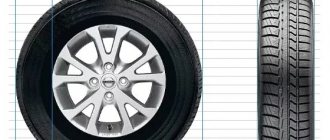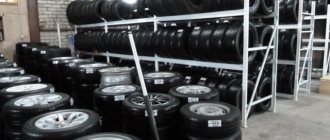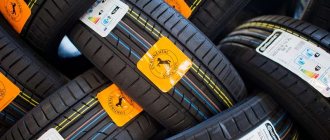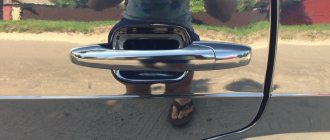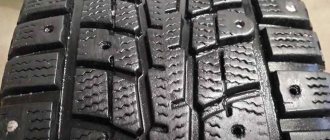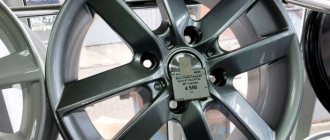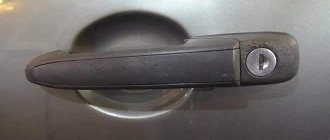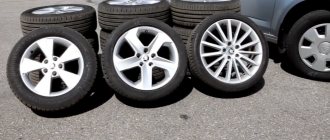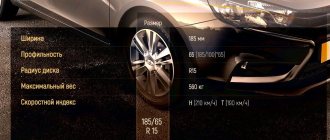Tires can be called the link between the car and the road surface. That is why the composition and design of tires has been constantly improved over many decades. According to accepted rules, a car is allowed to participate in road traffic only if the wheels are in proper condition. Inspecting tires from all sides allows you to obtain information about their condition, the technical condition of the car and the characteristics of the owner’s driving style.
Why it eats rubber is a fairly common question that can be found on various automotive forums. After all, some time after uneven wear is detected, the wheels may be unsuitable for use, since severe wear significantly impairs handling, increases braking distance, and reduces vehicle stability on the road.
Premature wear or eating rubber on the car from the outside front: treatment
Critical adjustments
The front suspension is a complex mechanism, but adjustable. Therefore, if you are eating tires from the inside of the front, you must first analyze its current settings. And premature wear of the outer shoulder is also a reason to inspect the relative position of the front suspension arms.
This chassis design is designed not only to optimize tire wear resistance. First of all, other goals are pursued - increasing the stability of the car and ensuring easy handling. In the adjustment process, it is customary to distinguish between three types of parameters:
- Camber is the angle between the longitudinal plane of the wheel and the vertical axis or the position of the wheels in relation to the road surface. Affects the area of the contact patch with the road. Preferably a negative value.
- Toe-in is the position of the tires relative to the horizontal plane. Required to compensate for the elastic movements of rubber parts when transmitting traction to the wheels.
- Caster is the angle of inclination of the transverse vertical plane of the wheel relative to the vertical axis. Needed to ensure self-return of the steering wheel when exiting a turn.
Accurate diagnosis
One-sided tread wear in most cases indicates that the above settings are incorrect. In particular, rapid wear of the tire's outer shoulders causes increased positive camber. In this case, the top of the tire is angled away from the center of the vehicle. There is no universally correct adjustment - each vehicle has its own set of standard values.
The collapse of convergence
Eating may occur on the inside or outside due to the incorrect location of the wheels relative to the vehicle body. In this case, after a long time, severe abrasion can occur on either side. When considering such a problem, the following nuances should be noted:
- Camber is an indicator that is responsible for the tilt along the vertical axis.
- Toe is an indicator that is responsible for the position of the wheel when turning.
Such indicators apply only to the front axle. What can seriously eat up the wheels after a few kilometers of travel?
If you change the wheel alignment settings, the cord wears out. At the same time, it eats the cord differently, depending on how the set parameters were reset. After a few hundred kilometers, the problem can manifest itself clearly, up to complete wear of the tread to the base of the cord.
Considering this question, we note the following:
- If it eats the inner side, then this indicates an excessive inward tilt. This situation is called negative camber. This situation occurs quite often.
- If the outer edge wears quickly, then this is positive wear. In this case, the wheels are tilted in different directions.
After 300-500 kilometers of travel, even a new tire can become completely unusable. However, it is worth considering that zero camber leads to uniform, but increased wear. This situation also leads to a significant increase in fuel consumption, and also increases rolling resistance.
The settings are reset for the following reasons:
- Due to prolonged use of the vehicle without proper maintenance. The alignment condition should be checked periodically. Long-term operation of the car on bad roads, which causes constant exposure to various loads, necessarily leads to changes in settings.
- If there is a strong impact while driving. Often, when hitting a curb or other serious obstacles, the alignment indicators change. Therefore, after such contact at high speed, the wheel alignment indicator should be checked.
- When carrying out any work related to the front suspension of the car. Carrying out repair work leads to the settings being lost. However, not all works cause this phenomenon.
- If important suspension elements are defective. Severe wear of the suspension elements also leads to the wheels being at the wrong angle to the body.
Checking the wheel alignment at a service station takes a little time. Modern equipment allows you to perform a quick and accurate alignment check. Experienced craftsmen perform the work of setting the required parameters within a short time.
What to do if you eat rubber from the inside front: possible reasons
A non-standard situation often occurs in the form of different wear on tires mounted on the same axle. Let’s say the right wheel “ate” from the outer end, the left one from the inner end. The exact reason is an incorrectly performed operation to adjust the geometry of the relative position of the suspension elements.
The real reason
The list of actions in the case of rubber eating on the outer side in front is partly relevant when identifying rapid wear of the inner shoulders. When identifying increased abrasion of the treadmill from the inner edge, the nature of the malfunction should be classified into one of the following groups:
- The side checkers are erased evenly - the camber angle is adjusted incorrectly.
- Saw-tooth herringbone wear – toe-in is not up to standard.
Options for combining the fixed types of worn tread geometry cannot be ruled out. Under such circumstances, experts talk about incorrect settings for both camber and toe. For your information. Not all vehicles provide the ability to adjust all three wheel angles. If there are defects and there are no necessary adjustments, the cause should be sought in non-original and worn suspension components (silent blocks and other bushings). Factory defects in tires or incorrect adjustment of landing gear levers should not be discounted.
There are often cases when the rear “eats” rubber on one of the sides. Worn rear suspension silent blocks are a likely cause of the malfunction. However, tuned struts and various types of spacers can also cause deviations in the geometry of the tires used.
The outer tread blocks have convex wear
Diagnosing such a problem is the most difficult because it is not visible visually. To determine the presence of convex wear on the side edges of the tread, you need to run your finger along them. You can feel that the low edges of the tread block are worn into a rounded shape, while the high edges, on the contrary, are pointed. If a similar problem occurs on your car, you need to check the wheel bearings and ball joints. It is worth noting that the outer tread blocks may wear out on one tire, while the rest will be fine.
Current issues
Why does the wheel alignment go wrong?
A bad road has a negative impact not only on the life of chassis components. It also leaves a negative imprint on their mutual position. Timely control of adjustments is necessary in the following cases:
- After a strong impact on the curb, holes, potholes and other uneven road surfaces.
- Upon completion of replacement of suspension elements.
Attention! Wear on the consumable components of the suspension structure also disrupts the installation angles.
The components are original and the wheel alignment is correct: the tire still wears unevenly
It is likely that the hub bearing has become unusable. If there is such a malfunction, it is difficult not to notice the play by rocking the wheel in different directions. While it is possible to deal with this ailment, it is difficult to change the incorrect geometry of the body. And due to the bent load-bearing part, there may well be rubber on the inside of the back or front of the car.
Premature wear does not meet the above criteria
Cases of asymmetrical “eating” of rubber products are discussed above. The following cases of tread wear should be classified as symmetrical:
- On both sides: low tire pressure.
- Center: increased tire pressure.
Tire aging
Even though rubber typically wears out before it reaches its expiration date, there are certain deadlines. Aging rubber can cause it to wear unevenly and severely. It is also worth noting that improper storage can lead to rapid aging of rubber.
All manufacturers indicate how long a product can last under certain operating conditions. It also indicates how it should be stored.
Aging of rubber leads to the fact that it loses its tightness and the structure becomes porous. After some time, moisture begins to penetrate deep into the structure. As a rule, manufacturers use metal cord to strengthen the structure. Moisture leads to the destruction of the metal base. According to accepted standards, a tire cannot be used after 10 years from the date of its manufacture.
Verdict
Possible malfunctions causing uneven tread wear are:
- Eats rubber from the inner edge. If there is a “herringbone” pattern on the treadmill, the problem is incorrect alignment; Even wear is due to a false camber angle.
- It eats rubber from the outer end - positive camber is to blame.
The wheel alignment settings are within tolerance - see the following:
- There is wear on the rubber suspension components.
- The correct shape of the rack flanges.
- Compliance of the design of support bearings and various spacers with the requirements of the manufacturer.
Asymmetrical geometry of the working part of the tire can also be caused by a damaged body. Another probable cause is noticeable play in the hub bearing.
Car tires, like all parts in a car, have their own specific service life; as a rule, with careful use and normal quality, tires last from 4 to 6 years. But intensive premature wear of tires often occurs; as motorists say, it eats rubber. Tires can be “eaten” in different places on the tread; wheel wear occurs on both the front and rear axles.
It is not easy to say unequivocally why rapid tire wear occurs; sometimes it is difficult even for experienced drivers to find the reason. But in many cases, the “zhor” of tires indicates existing faults in the car that need to be corrected.
Other reasons
The above reasons can lead to severe abrasion of the surface after several hundred kilometers. However, some malfunctions can also lead to minor wear, which will appear after several thousand kilometers. Such reasons include:
- Suspension fault. If the front suspension is associated with wheel alignment, then eating up the rear tires may be due to a faulty suspension. Incorrect placement of certain elements can cause the wheels to be positioned at a certain angle. An example is a violation of the position of the racks, as well as levers and other elements that influence the position of the rim.
- Changes in body geometry after an impact can also cause uneven wear. It is possible to identify such a situation only if you have certain equipment.
- The characteristics of the disk used can also lead to the problem in question. For example, after a strong impact, the shape of the disc may be disrupted.
The above reasons can also lead to abrasion on the inside of the tire. However, they are quite rare. The geometry of the body changes after a strong impact, suspension malfunctions that lead to wheel tilt are often corrected earlier, and modern rims are highly durable.
The main reasons why it eats rubber from the outside
Rubber on a car can be eaten both from the outside of the tread and from the inside; the main reasons for external intensive wear are:
- incorrect toe adjustment (the wheels are tilted in different directions more than they should be);
- the presence of play in steering rods and tips;
- factory defect of tires;
- high speed when cornering;
- insufficient tire pressure.
As a rule, when the outer part of the tread is intensively eaten away, the rubber emits an unpleasant squeak when entering turns. On many passenger cars, the tires on the front axle wear out first, since “burning” occurs when braking, and the load mainly falls on the front disc brakes.
Also, a hernia may appear on the outer side wall of the rubber, which occurs as a result of a side impact or falling into a hole on the road. It should be noted that a bulge on the tire does not always appear immediately; a hernia may be detected only after a week or even later. Cracks on the outside of a tire most often appear for two reasons:
- the car has been operated for a long time with low tire pressure;
- The tires have exhausted their service life, it’s time to replace them with new ones.
Another option is uneven wear on the outer part of the tread along the radius; some kind of bumps appear on it. The main reason for the occurrence of such a defect is a faulty suspension; broken shock absorbers are primarily to blame for this.
We carry out an inspection
The characteristics of the vehicle determine which side wears more heavily: the rear or the front. In order to assess not only the suitability of the tires, but also to determine the absence of problems with the technical condition of the car, you should inspect all 4 wheels.
Let us note:
- In a car that has a rear driven axle, it is the rear wheels that will wear out more; in a front-wheel drive car, on the contrary, the front wheels will wear out. This is due to the fact that the transmission of torque leads to an increase in the friction force between the wheel and the road.
- If, for example, a Fiat Albea has disc brakes at the front and drum brakes at the rear, the front wheels will wear out more. This is due to the fact that disc brakes are more efficient. Often, severe abrasion of one or another part of the wheel occurs during braking, since at this moment there is a large load on the axle.
Driving style always determines the degree and speed of wear. The more acceleration and braking while driving, the greater the wear.
When inspecting, it is worth considering that the cases under consideration determine uniform wear over the entire surface. Why is it eating rubber unevenly? The answer is quite simple - there is a malfunction that leads to this.
It is possible to determine whether the wheels are more eaten up on the inside or outside only after a fairly long period of time. This is due to the fact that only after several hundred kilometers it will become visible without the use of special instruments to measure the tread size.
Eats rubber from the inside on VAZ-2101-07 cars
On any car, the tread on those wheels that are driving wears out first, so on all rear-wheel drive VAZs, the tires on the rear axle are eaten up more intensively. The main reasons for the intensive wear of tires on the “Classic”:
- the geometry of the body is broken (usually after a blow to the rear);
- bent “stocking” (housing) of the rear axle;
- jet rods are faulty (bent, bushings are broken);
- crooked rims;
- Wheel alignment is not adjusted.
Uneven wear of the tread of one of the tires on an axle can occur due to different pressures in the tires, for example, in one wheel there is 1.5 Atm, in the other - 2 Atm.
The cause of tire burn on the front axle of a VAZ is often faulty silent blocks; here the internal bushings can become dislodged or broken. Also, rubber often wears out due to an impact on the wheel (falling into a hole at speed), in which case the tire on the side of the axle where the damage occurred is “eaten” more intensely.
The same problems with tread wear are observed on Niva cars, since the suspension of this model is structurally almost the same as on the VAZ-Classic.
Internal wheel wear: opinions of car owners
- “You hit a hole, check the camber”
After you hit a large hole on the road with your wheel, you should do a camber diagnosis. Many drivers neglect this rule. Moreover, they do not check the camber even during routine maintenance, and the car services themselves ignore this procedure. We often think about camber only when the car begins to actually eat rubber. At the same time, we often scold everyone around us, although our guilt in what happened is obvious. - “Careful with overload!”
When a car is overloaded, its wheels become a “house”. This is due to the features of the rear multi-link suspension, which is designed to ensure safe cornering. Therefore, if you often drive a car with a full load, you need to either accept the accelerated internal wear of the wheels for granted, or “cheat” the suspension design by adjusting the toe-in when the car is partially loaded (you can throw a couple of bags of potatoes in the trunk).Diagnostics of camber/alignment will never be superfluous, but in the absence of obvious wheel wear, many car enthusiasts forget about this procedure. I drove my car for 25,000 km without changing summer wheels and after carefully studying the tread pattern I discovered that the inner edges on the rear axle tires were worn out, but I often drive an overloaded car. After such a mileage as my tires, it is worth rearranging the wheels from the inside out. This procedure will help to wear the wheels more evenly. It is worth noting that radial tires (even if they are non-directional) should not be installed in such a way that the main direction of rotation of the wheel changes, so such tires are simply swapped on one axle.
- “Increased internal wear during sharp turns”
When the car sharply enters a turn, poorly inflated tires break, which is why the inner edge of the wheel begins to work more (accelerated wear occurs in this place). My car had this type of internal wear on all wheels. I admit, I didn’t control the tire pressure for a long time. - “Take into account the loading of the car when performing wheel alignment”
I recommend that you always adjust the camber on a loaded car and display the indicators at the beginning of the upper tolerance limit. The fact is that when exposed to different forces while the car is moving and there are a large number of silent blocks on the chassis, the parameters change very much. That is why the desired result is achieved. For example, the toe-in is set exactly according to the required parameters, but after the driver sits down, the front wheels begin to diverge and the toe-in indicators go into the red zone. If 2 passengers sit in the back of the car, then the camber also becomes abnormal. - “3D alignment is not a panacea”
After purchasing new tires, I made an alignment on a 3D stand. After that, I drove the car around, periodically checking the wear of the tires, and after a while I discovered that the tread was eaten unevenly. I visited many different services and checked the camber at different stands, but as a result, I brought all the indicators of the wheel alignment angles to such zones to ensure uniform tire wear. My recipe for uneven tread wear is to buy new tires and have the camber adjusted professionally on a high-precision stand.
Why does it eat rubber on the inside and outside at the same time?
It often happens that the rubber is “eaten up” on both sides of the tread at once; as a rule, in this case the car does not pull to the side, it drives straight. If this happens, most often the “to blame” is low pressure in the wheels, when the tread pattern wears out only in the middle - the car is constantly operated with tire pressure above normal.
Another option is that the inner part of the tread is “eaten up” on one front wheel, and the outer part on the other. In this case, most often the cause of the defect is incorrect wheel alignment adjustment, but on some car models the wheel alignment is not adjustable, for example, on Gazelle cars. On cars produced by GAZ, the camber is set from the factory, and a factory defect cannot be ruled out here. Another “culprit” of the malfunction is a worn hub bearing; its diagnosis should be carried out with the wheel hanging.
What other reasons could there be for wear on the inside of the wheel?
In some cases, internal tire tread wear can take on a completely unusual shape. For example, rubber wear looks like a narrow strip at the junction of the tread and the sidewall of the tire.
Craftsmen who regulate the toe-in of car wheels call this type of wear “band wear.” It should be noted that in our example, the wear is not related to the friction of the wheel on the fender or other part of the car, and is also not caused by extreme driving on 2 wheels or drifting. We are looking at “band” wear that occurs during normal vehicle use.
Sometimes wheel alignment specialists explain this tread wear due to mechanical damage to the tire, but it can appear on new tires that have not been subjected to any unusual impacts. Moreover, this type of internal wear can appear on the wheels of a perfectly good new car.
Based on the above, we can come to the conclusion that “band” wear of rubber is caused by a factory defect or a defect acquired during operation. But the real reason for such tread wear is incorrectly adjusted or disturbed wheel alignment. For some tire models, when rolling with slip, not the entire tread surface in contact with the road surface slips, but only a narrow strip at the border with the sidewall. There is an opinion that such wear is due to the peculiarities of the tire's load-bearing frame. The tread wear area is the hardest, so it slips every time the wheel slips.
Another unusual internal wear of a car wheel is called “fatigue spalling.”
In this case, there is destruction of the internal bonds of the rubber, noticeable to the naked eye, which leads to delamination of the tire material. Such internal wheel wear occurs due to poor quality tires caused by aging rubber, exposure to chemically active substances or violation of operational requirements (driving at a speed exceeding the threshold set by the tire manufacturer, too low tire pressure, improper alignment, etc.).
It should be noted that some car owners make a mistake when analyzing the internal wear of old, heavily worn tires. The fact is that abrasion of part of the tread on such a tire is not always a sign of accelerated wear of the tire tread of a particular wheel. There is a possibility that the rubber was “eaten” earlier, when it was on the wheel of another axle or even on another car (if a used tire was purchased). The more heavily worn part of the tread pattern will become “bald” faster than the rest of the tire's working surface.
Don't spend too much time analyzing old tires. It should be replaced with a new one (the average service life of passenger car tires is from 40,000 to 50,000 thousand kilometers or 5 years of operation).
It is worth considering another option for internal wheel wear, when the pitch between the teeth of the longitudinal “saw” is several elements (blocks) of the tread pattern. This type of tire wear is often observed on truck tires or high-profile SUV tires (when the tread pattern is formed by large “lug” elements). In this case, uneven tire wear is not so much a consequence of poor alignment as the result of play in the suspension or steering mechanism. In this case, internal tire wear occurs due to the fact that the wheel wobbles periodically while the vehicle is moving.
Why you need to pay attention to tire wear when buying a used car
If you are buying a used car, during the inspection it is important to pay attention to the condition of the tires; they can tell a lot (of course, if the tires are not new). As mentioned earlier, uneven tire wear can mainly be caused by the following reasons:
- Tire pressure is incorrectly adjusted.
- The wheel alignment angles are set incorrectly.
- There are faults in the suspension - there is play in the tie rods/tips, the silent blocks are worn out, the arms are bent, the shock absorbers require replacement, and so on.
- Wheel rims are deformed, causing imbalance.
- The geometry of the body is broken.
If the first four points are quite easy to deal with, and the cause of the malfunction can be eliminated, then with a violation of the geometry everything is more complicated; it may be violated as a result of a serious accident, and in this case it may not be possible to correct anything. Therefore, before buying a car with unevenly worn tires, you should ask the real owner to diagnose the car at a service station, and only after making sure that the body is in normal condition should you carry out the purchase and sale transaction.
Recommendations for extending tire life
Regardless of what the cause of tire wear was in your case, there are several simple recommendations that, if followed, will allow you to increase the life of your tires (no matter winter or summer). These include:
Measuring tread wear depth with a coin
- Correct tire pressure
. Its value must be checked approximately once every two to three weeks, and, if necessary, adjusted (pumped). Remember that low pressure not only wears out tires excessively, but also increases fuel consumption, and therefore your money. - Serviceable suspension
. Serviceable shock absorbers are not only synonymous with a comfortable ride, but also with low tire wear. Monitor their condition and, if necessary, repair or replace them. - Selecting the correct speed mode
. This is one of the most important factors affecting tire wear. Firstly, the faster the car drives (the wheel rotates), the faster the tires go bald. Secondly, when the car rolls in a turn at high speed, wear occurs on the outer and even side surface of the tire. Always adhere to the speed limit and try not to start or brake suddenly (and even more so with slipping or skidding). - Buy good tires
. We are not talking about expensive world famous brands. But it’s also not worth purchasing frankly low-quality tires. There is a high probability that such a tire will not last long. This means that you will have to go to the store again. Everyone knows the saying “the miser pays twice.” - Change tires on time in autumn and spring
. Not only is it dangerous to drive on summer tires in winter, but it also leads to wear when slipping on ice or snow. Likewise, it is not recommended to drive on winter tires in summer, especially if they have studs. This brings the tire to its wear limit.
The importance of correct tire pressure
Tires are inflated to a certain pressure so that the car can drive smoothly on the roads and maintain its weight. If the pressure is incorrectly set, fuel consumption increases, tires wear out prematurely, and the car handles and brakes worse.
The statement that on any passenger car you need to inflate tire pressure to 2 atm is incorrect; for each car the manufacturer sets its own parameters, usually they are indicated on the central pillar of the car on the driver's side, and information can also be marked on the gas tank flap from the inside.
When measuring with a pressure gauge, it is important to take into account that in warm weather the pressure in the tires increases, so you need to inflate the wheels in accordance with the season and the temperature at which the car is operated. And measurements must be taken at least once every three months, and before each trip the condition of the tires should be inspected.
Reading time: 7 minutes
Any experienced car enthusiast knows that for normal operation of a vehicle, it is not enough just to select the necessary tire, install it on the wheel, balance it and drive without the risk of accidents and premature wear. One of the most important actions that a car must undergo is adjusting the camber and toe, that is, aligning the position of the wheels in the horizontal direction to prevent excessive abrasion of the rubber.
Why does the tread eat unevenly?
Look under the front bumper from the front of the car - the wheels are not perpendicular to the road, but slightly inclined. Some inside, some outside. In general, the collapse, and what you see in this plane is called that way, can be positive and negative. It’s easier to figure out which one is which by looking at the photo.
Why not place the wheels rigidly straight in all planes? Why all these adjustments in the suspension? Here is a table showing what role each angle plays.
| Purpose of suspension settings | |
| Name | What provides |
| Camber | Increases the area of the tire contact patch with the road |
| Convergence | Compensates for the elastic movement of suspension parts (silent blocks and other rubber bands) |
| Custer | Helps return the steering wheel to its original position |
All values of these three characteristics are indicated in degrees (°), and if necessary, they are expressed to arc minutes and seconds. Each car has its own. Look for the true values in the operating manual, and the actual values on the printout that should be given at the wheel alignment. Deviations from these angles are not allowed, otherwise the tire will be eaten from one side. However, the suspension is not always to blame. A banal difference in tire pressures also does not lead to anything good. What exactly is the reason will be revealed by the nature of the “zhora” of the wheel, photos of which you have already looked at.
The reason for the treads eating up on the inside of the front axle
Many car enthusiasts who do not have sufficient driving experience often have the question of why they are burning rubber on the inside of the front axle. Several reasons for this defect can be identified, and none of them depends on the other, in particular:
- The most common problems are problems with wheel alignment and camber, and this may have nothing to do with adjustment, because their position is not constant and can easily change due to strong impact or vibration. In order for the driver to identify a problem with alignment and camber, he can simply accelerate on a straight, level road and let go of the steering wheel for a few seconds. If the car pulls to the side, this is one of the signs of a violation of this regulation.
Eating rubber from the inside of the front
- Also, the problem of wear on the wheels on the inside can occur when there is insufficient pressure in them, when the middle of the sole contact with the road bends, and the shoulder protectors, on the contrary, wear out faster.
- If a car enthusiast purchases a cheap replica instead of an original tire, then there is a high probability of a defect in the manufacture of the wheel. This situation, as a rule, causes uneven distribution of masses, runout at speed, unnecessary vibrations and, most importantly, uneven wear of the treads.
- Some cars are designed to tilt their wheels slightly when turning, and engineers deliberately use this technique to shorten the vehicle's turning radius. In such cases, the wheel has a contact patch with the road only along one part of the sole, which inevitably leads to tire wear on one side.
- If a tire is used for several seasons in a row, then there is a high probability of its fatigue, which causes plastic deformations of the hernias and, as a result, destruction of the treads from friction with the road surface.
Manufacturing defects
There is a low probability that there was a manufacturing defect and uneven wear occurs due to the irregular shape of the product. That is why you should purchase products only from trusted manufacturers.
Among the most common problems are the incorrect composition of the rubber used, the wrong shape of the court, and other defects. Unfortunately, it is practically impossible to check the quality of tires without special equipment.
How does the wear mechanism of the driving front wheels occur?
When the above reasons occur, drivers begin to notice how they eat rubber from the outside in front, and the physical process that occurs in such a situation is described below:
- The contact of the tire sole does not occur evenly over the entire traction area, but only along one of its parts, and the wheel can not only roll without encountering resistance along the way, but also slip during acceleration, braking or cornering.
- The hard surface acts as an abrasive on the tread, and always causes micron layers of the tire sole to be destroyed during each ride.
- Considering that the uneven distribution of the contact surface causes an increase in pressure per unit area, wear in a given location occurs several times more intense due to the concentration of stress at one point, which causes the so-called eating.
Causes of premature tire tread wear due to the driver's fault
As we have already figured out, intense tread wear is most often a consequence of problems in the car, but it is not so rare that the car owner himself is to blame for the rapid failure of tires, and here are the main reasons:
- driving a car on bad roads;
- aggressive driving style (driving with sudden starts and braking, long trips along the highway at high speed);
- irregular maintenance, untimely repairs.
If the tires wear out quickly, but there are no obvious technical problems, the driver should think about whether he is operating his car correctly, maybe he should change his driving style, and regularly monitor the technical condition of the car.
The main reasons for eating up tires on the rear wheels
So, this defect most often occurs due to the following factors:
- Of course, a violation of toe-in and camber, just like for the front wheels, is one of the main reasons for eating up rubber.
- It sometimes happens, especially in relation to domestic cars of old models, that the rear axle has dependent wheels, and it is a solid beam, it is not possible to check the position of the wheels on which and adjust them. In such cases, the causes of the defect may lie in non-design bends of the massive beam itself due to the car falling into a deep hole at speed, and the problem will have to be corrected at the exhaust stand.
- During tire fitting, mechanics often show irresponsibility by not using a torque wrench when tightening the nuts on the studs that hold the wheel to the hub. In such cases, misalignment may also occur and, as a result, eats the rubber from the inside, front or rear, with all the ensuing consequences.
- Unlike the front axle, for correct adjustment of the rear wheels it is extremely important to carry out all control measurements with a full tank, since it is located just at the back, and gasoline can weigh up to 50-70 kg. Thus, when adjusting the angle of the wheels with an empty tank during the next refueling, the car may well sag and the wheels will begin to eat up.
Rubber eating at the rear
- The last thing that is especially acute for cars with a large trunk, for example, SUVs, minivans or pickups, is the problem of overload, since drivers sometimes neglect the permissible curb weight of the car, the excess of which is often reflected in the condition of the suspension and, as a result, affects the alignment of the wheels. .
Epilogue
In conclusion, we note that timely detection of the problem will eliminate the problem and preserve the integrity of the tire. Timely detection of the problem is possible by constantly visiting a service station. When inflating wheels or diagnosing the suspension, you should pay attention to the condition of the tread.
Tired of paying fines? There is an exit!
Forget about fines from cameras! An absolutely legal new product - Traffic Police Camera Jammer, hides your license plates from the cameras that are installed in all cities.
More details at the link.
- Absolutely legal (Article 12.2);
- Hides from photo and video recording;
- Suitable for all cars;
- Works through the cigarette lighter connector;
- Does not cause interference to radios and cell phones.
Basic mistakes when adjusting the front wheels
Many experienced car enthusiasts have encountered such a problem when, after the next scheduled maintenance, the inside of the front wheel suddenly begins to wear out. This is primarily due to a violation of technology during the adjustment of toe-in and camber, since this procedure must be carried out on a special stand using appropriate equipment and professionally trained craftsmen. If the procedure is carried out with violations, then a result occurs called critical adjustments, which is expressed in the following criteria:
- Regardless of the class of the passenger car, when adjusting the camber, it is advisable to maintain a negative angle for the front axle, because the mechanism for turning the constant load from the engine brings them into balance in this position.
- When setting the correct toe angle, that is, the positioning of the wheels in relation to the horizontal surface, it is, on the contrary, necessary to give the value only positive values in order to achieve ideal balance while driving at high speed. It is this kind of adjustment that can guarantee that the grip spot with the road, if the wheel is not overinflated relative to standard values, will cover the entire area of the wheel sole, which in turn will ensure ideal traction and transmission of all torque to the tire without any losses.
Caster Angle Adjustment
- The last important indicator, which many tire service technicians completely neglect, is caster. This parameter is an angular value that characterizes the inclination of the projection of the vertical plane across the diameter of the wheel relative to the perpendicular, lowered strictly vertically from the point of attachment of the disk to the hub. The importance of correct positioning of this parameter is obvious, since automatic return of the steering wheel to its original position is possible only if correct adjustment is ensured.
- Accordingly, a correctly aligned steering linkage can guarantee that the wheels will be aligned strictly coaxially with the trajectory of movement, and during driving there will be no effect of their partial skidding, which is inevitably accompanied by abrasion of some of the treads.
Thus, after 10,000 km of mileage after incorrect adjustment of toe-in and camber, tires may have a difference in tread height on the central and inner parts of up to 5-6 mm, which indicates the need to replace them, since such a defect cannot be restored in any way even after wheel alignment.
Correct adjustment of toe and camber at service stations
If a driver notices one-sided wear on the sole of his tire, this should signal him that he needs to contact a tire service in the near future. Otherwise, eating up the rubber can lead to more serious consequences, including the formation of a hernia, or sudden rupture of the wheel, which can pose a danger to the driver or his passengers, as the car loses control.
Low pressure
Not only different, but also low pressure can lead to a decrease in the service life of the purchased tire. This is due to the fact that tire manufacturers create designs taking into account recommended operating conditions. If you operate the wheels with low pressure, they begin to wear out quickly. In this case, the load will fall on the part that is not intended for this.
A low pressure indicator determines the following:
- The structure begins to sag at the edges.
- The rim may come into contact with the tire surface, which will increase wear.
However, high pressure also causes eating to begin in the central part.
That is why you should constantly pay attention to what the pressure is. It is worth inflating the wheels to the level recommended by the manufacturer.
Flat wear spots
What it looks like: One spot on the wheel has more wear than the other.
Cause: Single spots of increased wear on the surface of the tire often occur when forced to suddenly brake or skid, or when steering out of a situation in order to avoid an impact (for example, if a moose or other animal suddenly runs out onto the road). This kind of wear will be especially visible after sharp braking with a simultaneous skid if the car does not have an anti-lock braking system.
The fact is that when braking sharply and steering out in order to avoid an impact, a car without ABS is more susceptible to skidding with locked wheels, which will lead to something like this type of worn spot on the tire tread.
Similar stains can also appear in cars that have been parked for a long time.
Remember that when you park your car for a long time, you risk your tires, where wear spots will appear on the tires of your car due to the uneven distribution of the weight of the car on them. The fact is that during parking, the rubber tread does not come into complete contact with the surface and, as a result, a certain section of the rubber is deformed from long-term parking.
How to find out the technical serviceability of a car by the condition of the tires.
A car's tires are the only element of the vehicle that connects it to the road. Car owners often forget that rubber is the most important element of a car, which directly affects our safety. But when the tires wear out, every driver realizes with disappointment that it’s time to spend money on buying new tires. But purchasing new tires does not always save the situation. After all, sometimes tire wear can indicate possible car malfunctions. In this case, replacing tires with new ones may not help. For example, with some types of breakdowns, your new tires may wear out prematurely in a short period of time. Let's look at the ten most common types of tire wear by which it is quite possible to determine the cause of this wear, ultimately finding out the technical condition of the vehicle.
The problem is definitely not wheel alignment.
- Eats rubber around the edges. There is only one reason for this: the tire has low pressure.
- The tire was eaten in the middle. This happened because she had high blood pressure.
- On one axle, the right tire wears out faster than the left, or vice versa. Due to the difference in pressure between wheels located on the same axle, the car is pulled to the side with a tire with a reduced air volume. The same cylinder experiences additional frictional force, which causes it to wear out faster.
- The wheels wear out in bumps. Occurs due to imbalanced balancing, resulting in lateral runout of the disc.
Tire cracks
Another problem that can result from high or low tire pressure is cracking.
A tire hitting a curb or hole is a stressful condition for the tire, which it can withstand without damage at ideal pressure. If longitudinal cracks appear on the sidewall of the tire, it means that it has been used for a long time at insufficient pressure. Also, small cracks may appear on the tire, and from them you can tell that the rubber has reached the end of its service life. In such tires, the chemical decomposition of elements begins, which allow it to maintain its properties. It follows from this that the use of such tires is prohibited.
Bald spots on the tire
If there are certain areas on a car tire that are more worn than the rest, they are usually called “bald spots” or spots. Most often, such spots appear on the cars of drivers who like to accelerate and brake sharply. During rare (including emergency) braking, if the car does not have an ABS system, the wheels are blocked and the car slips on the tire along the road surface. Sliding leads to an increase in tire temperature and immediate wear.
In addition, spots on your car's tires can appear if it sits idle for a long time. When parked for a long time, a separate section of the tire bears the entire weight of the car. Due to its structure, it can become deformed over time.
Dents in rubber
What it looks like: According to long-term observations, rubber with dents looks like in the photo. That is, the tire has the shape of bumps and dents.
Reason: This type of tire is usually associated with a malfunction of the vehicle's suspension (wear or damage to the elements of the vehicle's chassis). Due to a faulty suspension, shock mitigation on bumps is insufficient. As a result, the tire experiences overload from impacts, taking on the maximum load. But the load is distributed unevenly over the entire tread surface. As a result, some areas of the tread take on more stress than others, which contributes to the formation of dents and bumps in the tires.
Most often, this appearance of used tires is associated with poor shock absorbers. Although it is worth noting that any parts of the suspension that have failed can cause such wear and tear.
We advise you, if such tire deformation is detected, to have a complete diagnosis of the vehicle’s suspension and struts done at a technical center. We do not recommend taking this problem to a tire shop, i.e. in order to determine the reason for the change in the shape of the wheels. It is not uncommon for tire service workers to not know what can cause irregularities (dents, bumps) to appear on the tread surface.
Most often, tire service workers claim and believe that this is the reason for the incorrect alignment. But this is not a fact. As we have already said, this reason may be related to the failure of the shock absorber(s).
Tire wear | Autoblog
Winter is slowly but surely coming to an end. Soon you will need to change back to summer tires. But until she has changed her shoes, she needs to carry out a technical inspection, check for wear. After all, it will help you identify hidden defects in your car, as well as suggest correct operation...
Today I want to teach you how to identify hidden defects using tire wear. Many of us, especially those who started their driving careers with our VAZ 2101 - 2106, remember wear and tear on the inside. Sometimes such that the inside of the wheel turned out to be completely “bald”. At the same time, they continued to drive on such a tire before. I myself, when I was just starting my driving career, this was 15 years ago, also killed tires, this happened on my first car, a VAZ 2101. Then I did not know why this was happening. But in vain, this knowledge would have helped me save the tire. If you have wear and tear and don't know where it comes from then the following information is for you.
It's all about the alignment of the car. If these settings are violated, then wear is guaranteed. To begin with, without delving into the essence of the issue, I will say that it is very easy to reset these settings (alignment - camber). At high speed we flew into a large hole, so that the disk was bent, all this was enough to throw off these settings. And accordingly, wear may occur. Therefore, after a strong blow to the suspension, you need to go to a service station and check the wheel alignment settings. This is my advice to you, otherwise it will cost more later when the rubber “covers up.” And tires are not cheap now.
